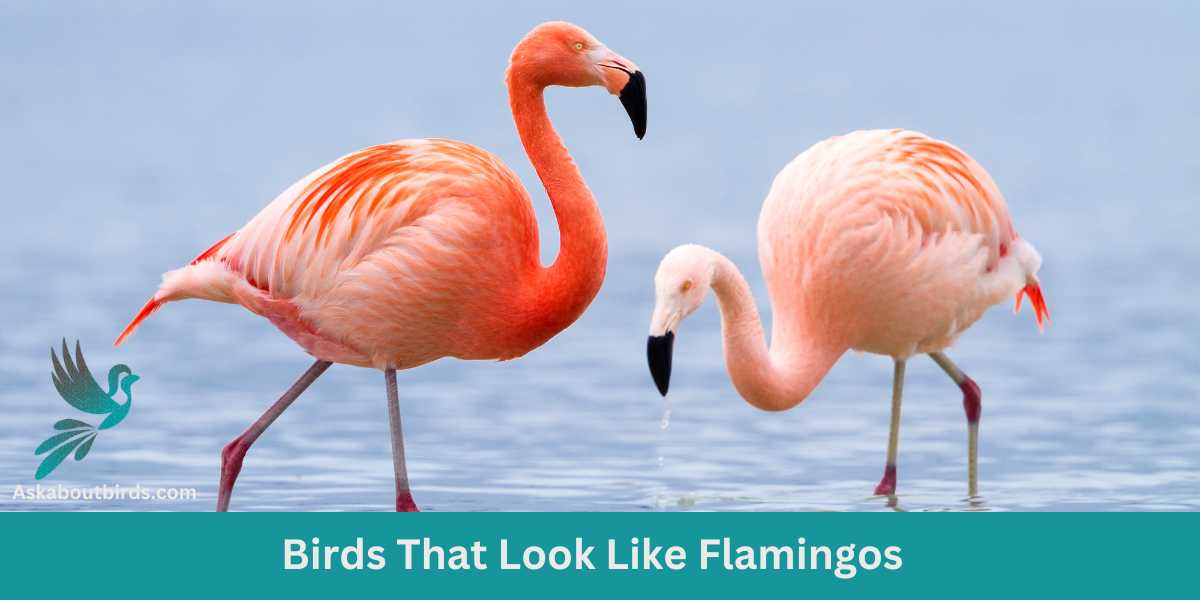Flamingos, with their distinct pink hue, long, thin legs, and graceful necks, have always held a unique fascination for bird watchers and nature lovers alike. Their undeniable elegance and striking color palette make them a bird-watcher’s delight.
But did you know there are several other birds that echo the flamboyant flamingo’s captivating charm?
From spoonbills to egrets, let’s embark on an exciting journey to discover 11 feathered friends that reflect the allure of Flamingos, each one with its own unique twist.
Birds That Look Like Flamingos
Roseate Spoonbill

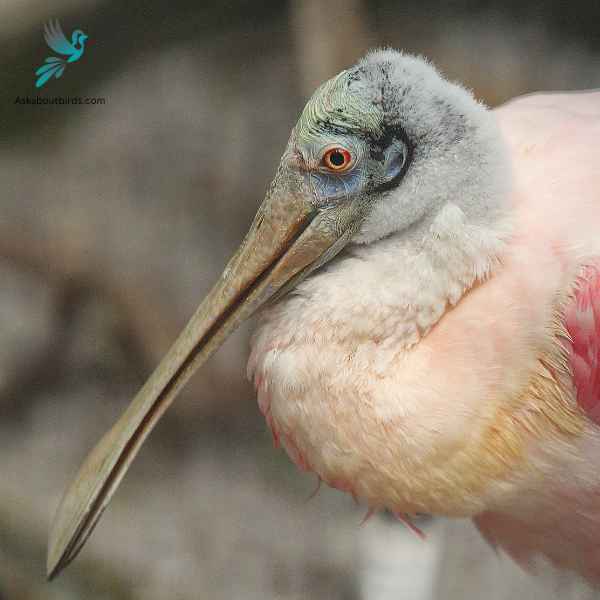
| Feature | Measurement |
|---|---|
| Scientific Name | Platalea ajaja |
| Length | 28–34 in |
| Wingspan | 47–52 in |
| Weight | 1.2–1.8 kg |
The Roseate Spoonbill (Platalea ajaja) is a large, long-legged wading bird known for its unique spoon-shaped bill and striking pink plumage, from which it derives its name.
The species’ eye-catching coloration ranges from light pink to bright magenta, accentuated by a patch of carmine red on the wing and a greenish tinge on the head and neck. The spoon-shaped bill, broad and flat at the end, is a highly specialized tool for feeding, allowing the bird to sweep through the water and scoop up small aquatic animals.
Residing in marshes, lagoons, and mangroves, the Roseate Spoonbill is found in the Americas, from the southern United States through Central America and into South America. They feed on crustaceans and other small aquatic animals, the carotenoid pigments of which contribute to their vibrant pink color.
Painted Stork

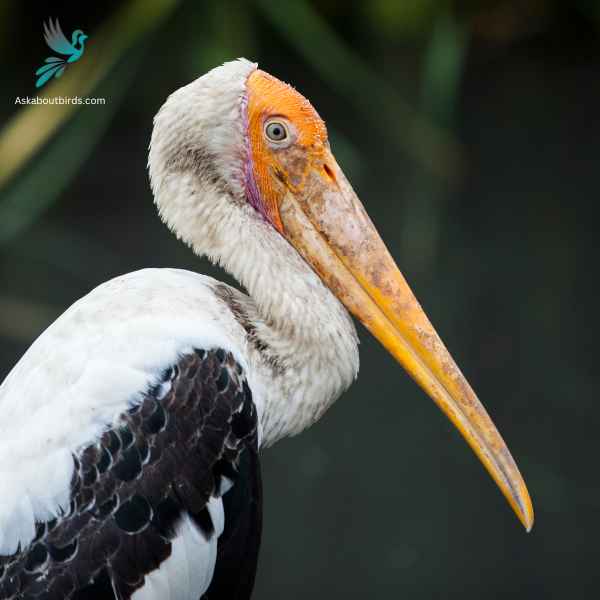
| Feature | Measurement |
|---|---|
| Scientific Name | Mycteria leucocephala |
| Length | 36.5–40 in |
| Wingspan | 59–63 in |
| Weight | 2–3.5 kg |
The Painted Stork (Mycteria leucocephala) is a large and distinctive bird native to the wetlands of tropical Asia. Its name stems from the beautiful array of colors adorning its body, including pink-tipped tail feathers, a yellow beak, and a striking black and pink wing pattern visible during flight. The head and neck of the bird are starkly white, with a unique “painted” effect created by the orange-yellow coloring on the head of mature individuals.
In terms of behavior, Painted Storks are primarily non-migratory and prefer habitats near freshwater sources like rivers, lakes, and marshes. Their diet consists mostly of fish, which they catch using a unique technique called ‘tactile fishing’, where they sweep their half-open bill through the water and snap it shut upon contact with prey. Unfortunately, this species is listed as Near Threatened due to habitat loss, pollution, and hunting. Conservation efforts are in place to protect their habitats, prevent hunting, and monitor populations to ensure their survival.
Scarlet Ibis


| Feature | Measurement |
|---|---|
| Scientific Name | Eudocimus ruber |
| Length | 22–25 in |
| Wingspan | 21 in |
| Weight | 1.4 kg |
The Scarlet Ibis (Eudocimus ruber) is a striking bird native to South America and the Caribbean, most notable for its vibrant red coloration. This medium-sized wading bird has a long, curved bill and a body entirely covered in brilliant red feathers, except for the tips of their wings which are a more subdued, dark shade. The color results from pigments in their diet of crustaceans and other small aquatic animals.
Scarlet Ibises thrive in a variety of wetland habitats, including mudflats, shallow lakes, and mangrove swamps, where it uses its long, probing beak to find prey in soft mud or under shallow water. It’s also a social species, nesting in large colonies, often with other wading birds. While it’s currently not considered endangered, the Scarlet Ibis faces threats like habitat loss and illegal hunting for its vibrant feathers.
American White Ibis
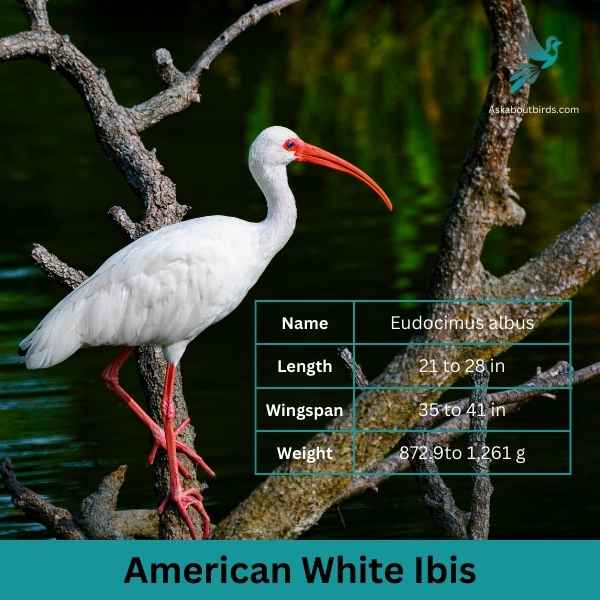
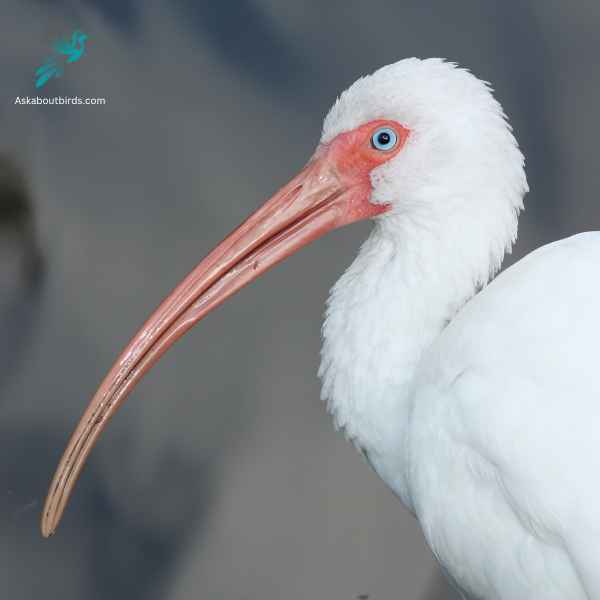
| Feature | Measurement |
|---|---|
| Scientific Name | Eudocimus albus |
| Length | 21 to 28 in |
| Wingspan | 35 to 41 in |
| Weight | 872.9to 1,261 g |
The American White Ibis (Eudocimus albus) is a distinctive bird with an all-white body, bright red-orange down-curved bill, and long legs. During the breeding season, the color of their bill and legs deepens, and they develop a pale blue facial skin. Immature birds are brownish-gray with a white belly until their second year, when they molt into the adult’s white plumage.
Inhabiting the wetlands, marshes, and coastal habitats of the southeastern United States, the American White Ibis is known to travel in large flocks, often flying in a V formation. They are omnivorous birds that predominantly feed on crustaceans and other small aquatic animals that they find by probing their long beaks into soft muddy bottoms of shallow waters.
Sandhill Crane

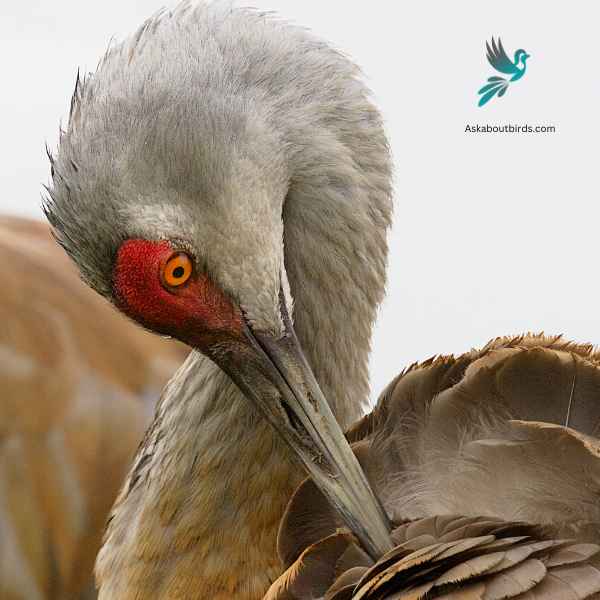
| Feature | Measurement |
|---|---|
| Scientific Name | Antigone canadensis |
| Length | 2 ft 7 in to 4 ft 6 in |
| Wingspan | 16.5–23.6 in |
| Weight | 4.02-4.57 kg |
The Sandhill Crane (Antigone canadensis) is a distinguished bird species found in the family Gruidae, renowned for its majestic presence and elaborate courtship dances.
These long-legged birds stand approximately 4 feet tall with a wingspan of up to 7 feet, marked by gray bodies, white cheeks, pointy dark bills, and an iconic red cap on their heads. Typically, they inhabit grasslands, marshes, and fields across North America, Siberia, and Cuba.
Being omnivorous, Sandhill Cranes thrive on a varied diet consisting of plant material, small mammals, amphibians, and insects. With a lifespan reaching up to 20 years in the wild, they remain one of the most widespread crane species globally.
White Stork
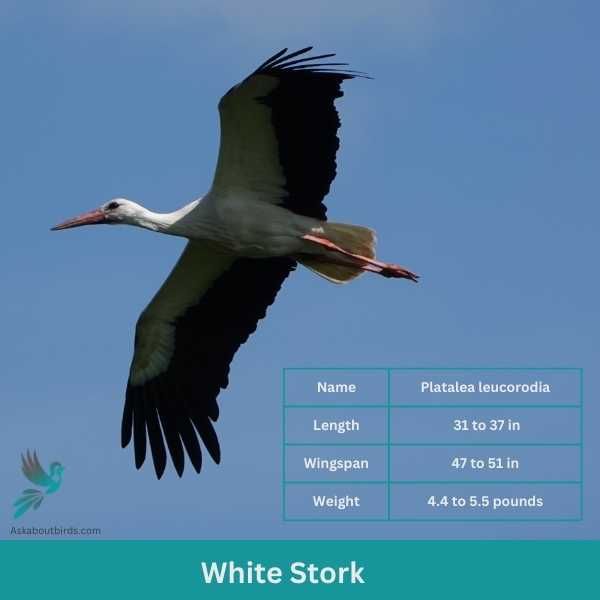

| Feature | Measurement |
|---|---|
| Scientific Name | Ciconia ciconia |
| Length | 39–45 in |
| Wingspan | 61–85 in |
| Weight | 5.1–9.7 lb |
The White Stork is a large, elegant bird notable for its contrasting black and white plumage. These storks forage in grasslands and shallow wetlands, hunting for a range of food items, including insects, fish, amphibians, reptiles, small mammals, and birds.
The White Stork is a tall, long-legged wading bird. Its distinctive bill is long, straight, and pointed, perfectly adapted for hunting. Adults are primarily white with black flight feathers, while the legs and the long bill are bright red. Immature storks resemble adults but have duller plumage and a darker bill.
The vocal sounds of the White Stork are not as prominent, as they are mostly silent. However, they are known for their unique way of communication through “bill-clattering”, a rapid opening and closing of their beak producing a rattle-like sound.
Great Egret
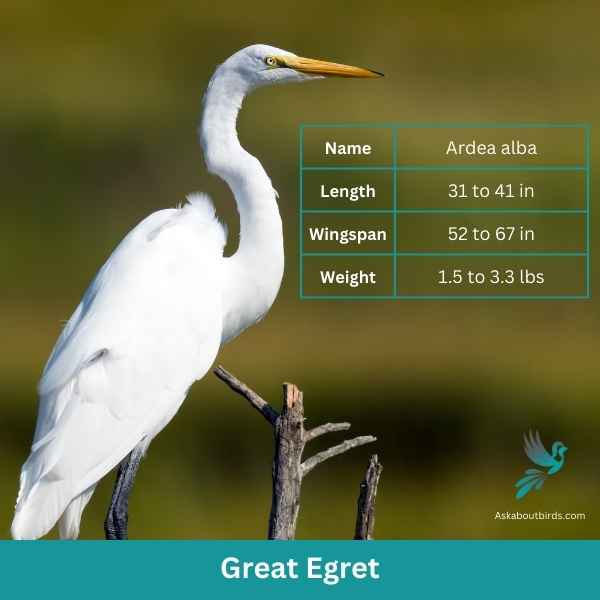
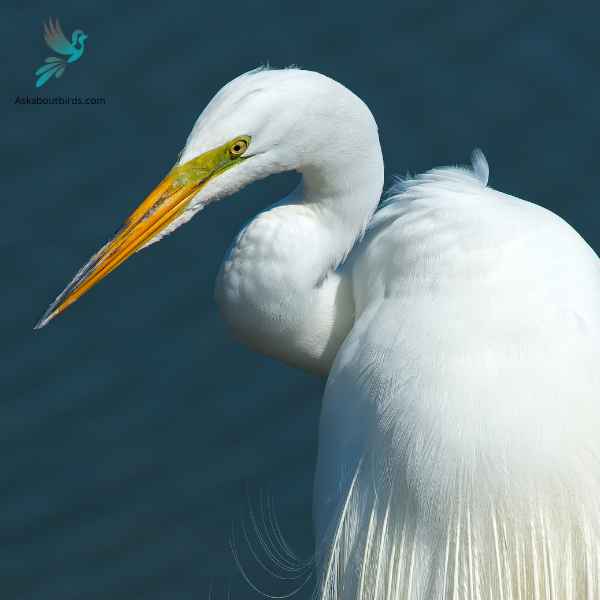
| Feature | Measurement |
|---|---|
| Scientific Name | Ardea alba |
| Length | 31 to 41 in |
| Wingspan | 52 to 67 in |
| Weight | 1.5 to 3.3 lbs |
The Great Egret (Ardea alba), also known as the Common Egret, is a large, elegant wading bird recognized for its brilliant white plumage, slender black legs, and long, dagger-like yellow bill.
With a height of up to 3.3 feet and a wingspan of 52 to 67 inches, this bird is amongst the largest of the heron species. Its stately appearance and serene comportment have made it a popular symbol in many cultures and an eye-catching sight in its habitats.
Found across all continents except Antarctica, the Great Egret resides in both fresh and saltwater wetlands, including marshes, ponds, and coastal areas. It feeds mainly on fish, but it also hunts amphibians, small mammals, and invertebrates.
Reddish Egret
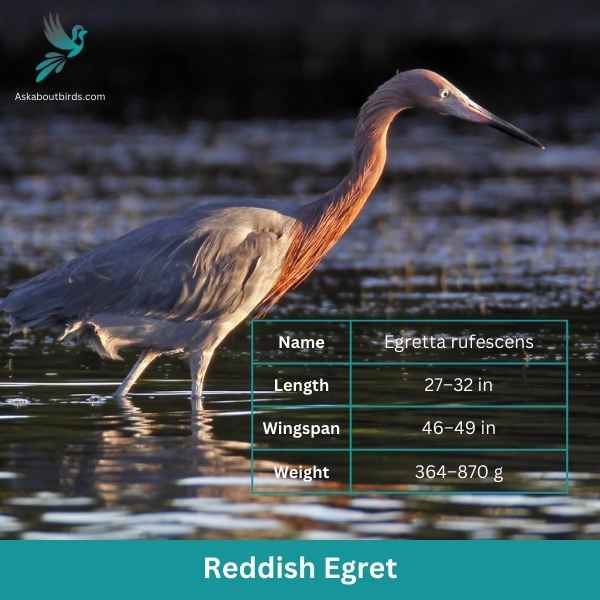
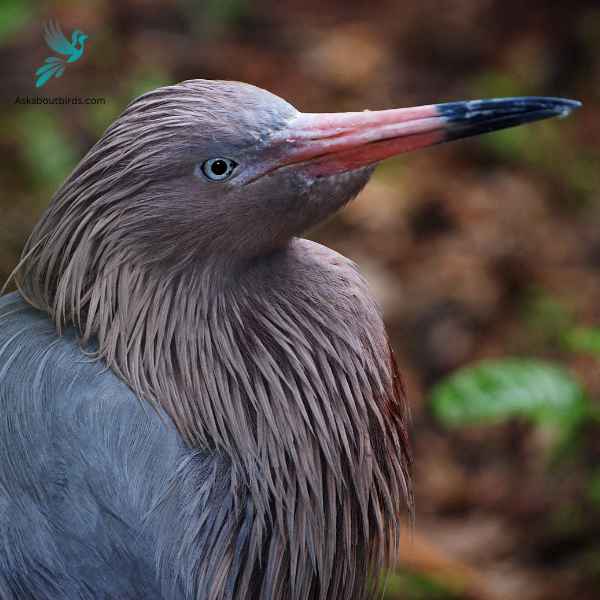
| Feature | Measurement |
|---|---|
| Scientific Name | Egretta rufescens |
| Length | 27–32 in |
| Wingspan | 46–49 in |
| Weight | 364–870 g |
The Reddish Egret (Egretta rufescens) is a medium-sized heron species recognized for its unusual coloration and lively hunting behavior.
It comes in two distinct color morphs: a dark form that displays a bluish body with a reddish neck and head, and a white form that is entirely white. Its bill is pink at the base, transitioning to black towards the tip, and its legs and feet are bluish-gray.
The Reddish Egret’s habitat stretches along the coastal regions of the southern United States, Mexico, Central America, and the Caribbean, where it frequents saltwater marshes, lagoons, and shallow bays. It is known for its “dance” when hunting, running in shallow water with wings spread and dipping its head to catch fish.
African Spoonbill
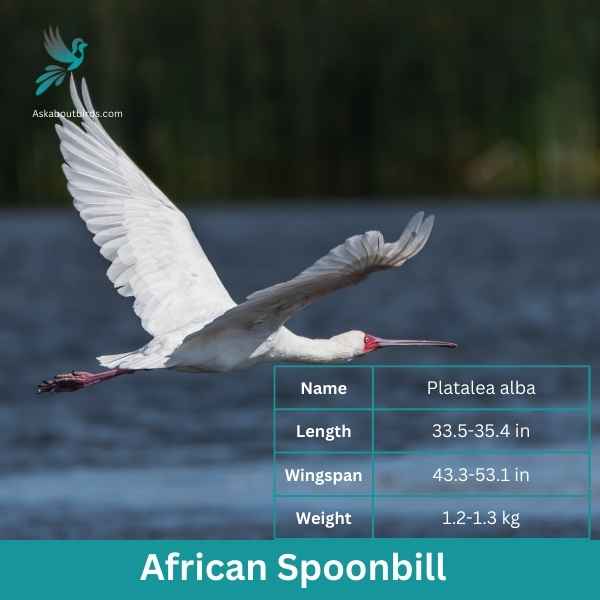
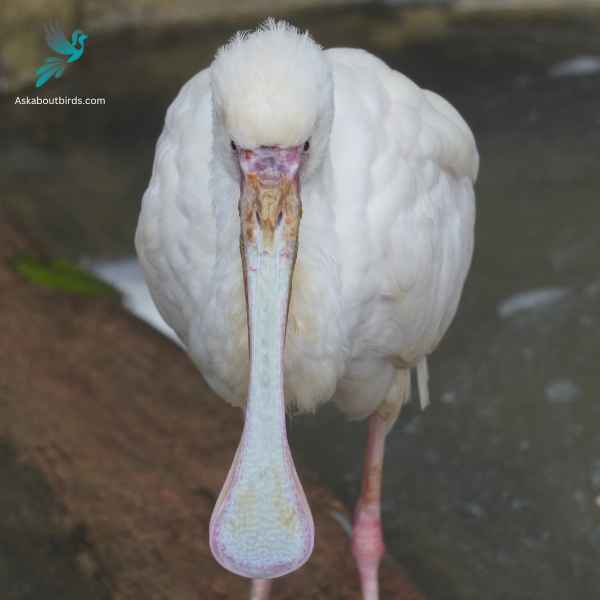
| Feature | Measurement |
|---|---|
| Scientific Name | Platalea alba |
| Length | 33.5-35.4 in |
| Wingspan | 43.3-53.1 in |
| Weight | 1.2-1.3 kg |
The African Spoonbill (Platalea alba) is a long-legged wading bird found throughout Africa south of the Sahara. This bird stands out due to its unique, spoon-shaped bill, which is used to sweep through water in search of prey. The African Spoonbill is mostly white with a red face, legs, and feet, and during the breeding season, it develops a crest of feathers on the back of its head.
The African Spoonbill thrives in a variety of wetland habitats, from marshes and swamps to lakes and riverbanks. Its diet primarily consists of aquatic invertebrates, small fish, and amphibians. The bird uses its signature bill to feed, sweeping it from side to side in the water to detect and catch prey. The African Spoonbill typically nests in trees, often in colonies with other water birds. Although the species is not currently threatened, it can be negatively impacted by habitat degradation, pollution, and human disturbance. Conservation strategies largely involve the protection and management of wetland habitats.
Glossy Ibis
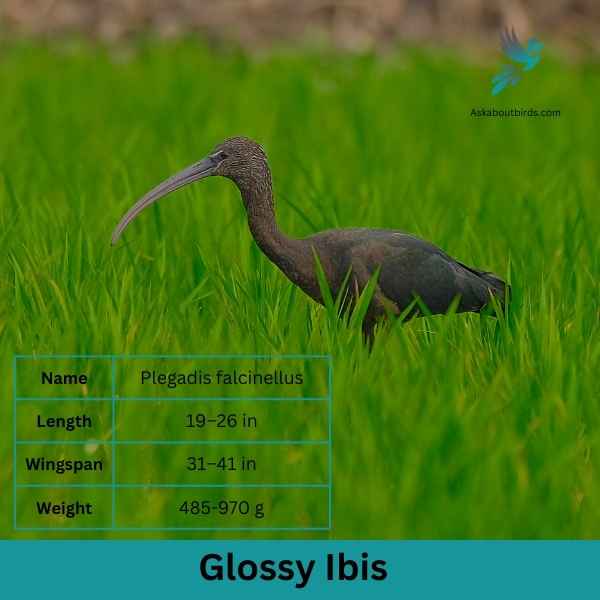

| Feature | Measurement |
|---|---|
| Scientific Name | Plegadis falcinellus |
| Length | 19–26 in |
| Wingspan | 31–41 in |
| Weight | 485-970 g |
The Glossy Ibis (Plegadis falcinellus) is a wading bird that stands out due to its rich, iridescent plumage that appears glossy in the sunlight, showcasing a blend of purples, greens, and browns. This species features a long, down-curved bill and red eyes, which add to its unique charm. Found in a variety of regions worldwide, including parts of the Americas, Europe, Asia, Africa, and Australia, it’s the most widespread ibis species.
The Glossy Ibis favors wetland habitats where it can probe in the soft mud for a diverse diet of insects, small fish, and crustaceans. It nests in colonies, often with other wading birds, building platform nests in trees or reeds. While the global population of Glossy Ibis is large, it faces potential threats such as habitat loss due to drainage of wetlands, pollution, and disturbance. Conservation efforts are focused on habitat protection and restoration, along with monitoring of populations to prevent significant declines.
White-faced Ibis
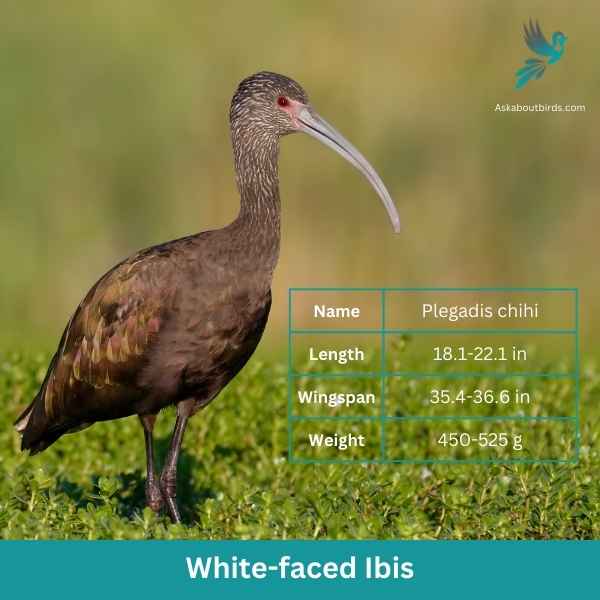
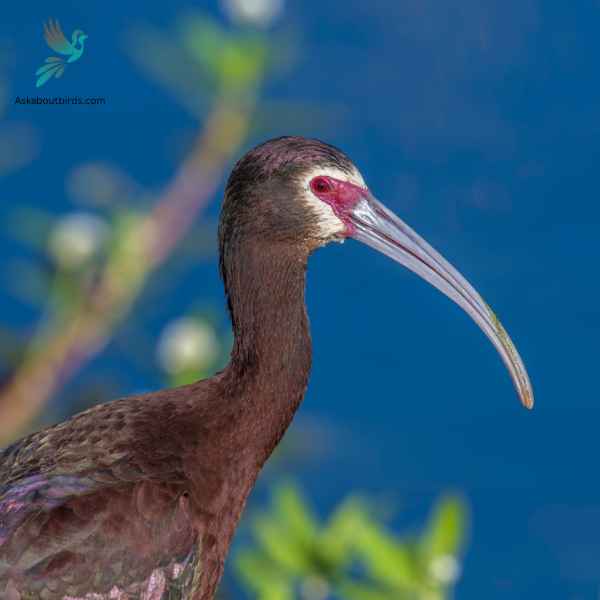
| Feature | Measurement |
|---|---|
| Scientific Name | Plegadis chihi |
| Length | 18.1-22.1 in |
| Wingspan | 35.4-36.6 in |
| Weight | 450-525 g |
The White-faced Ibis (Plegadis chihi) is a wading bird notable for its distinctive and colorful appearance. It boasts a long, curved bill, a slender body, and a predominantly dark, glossy plumage that shimmers with iridescent hues of green and purple in the sunlight.
The bird derives its name from the patch of white feathers bordering the bare, red skin on its face, a feature most prominent during the breeding season.
Inhabiting the marshes, wetlands, and fields of the central and western United States, as well as parts of Central and South America, the White-faced Ibis uses its long, curved bill to probe mud and shallow water for various invertebrates and crustaceans. The species tends to nest in colonies, often sharing habitat with other wading birds.
Great Blue Heron
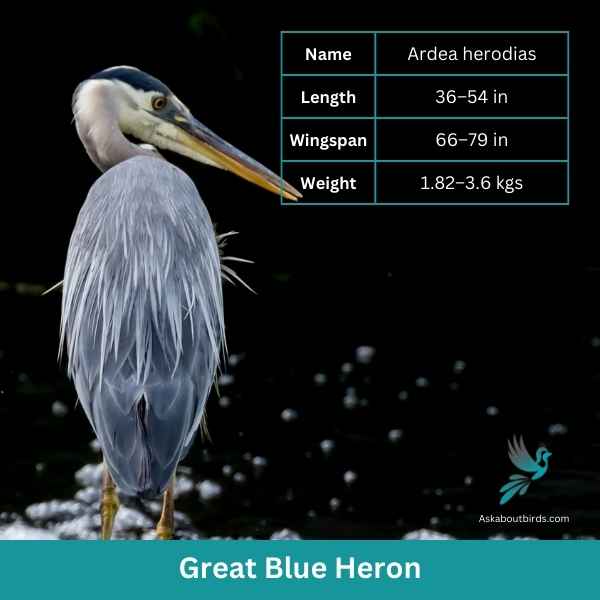
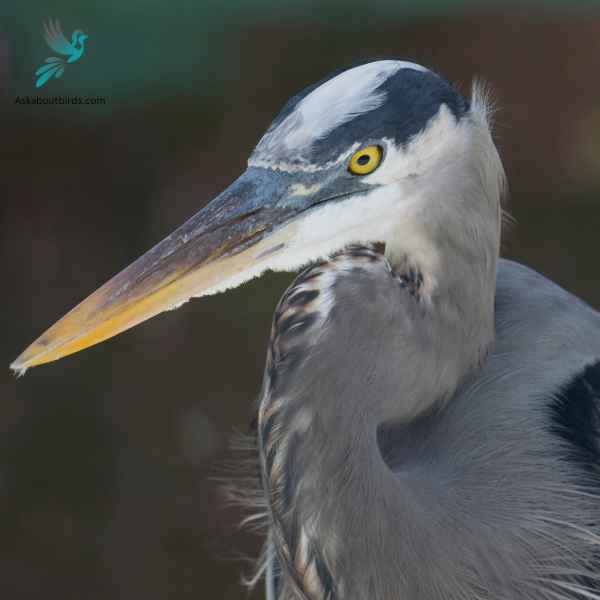
| Feature | Measurement |
|---|---|
| Scientific Name | Ardea herodias |
| Length | 36–54 in |
| Wingspan | 66–79 in |
| Weight | 1.82–3.6 kgs |
Great Blue Herons are the largest heron species in North America, is distinguished by its tall stature and unique blue-gray plumage.
Measuring up to 4.5 feet tall with a wingspan of approximately 6.5 feet, the bird features a long, pointed bill, a white head with a black eye stripe extending to slender black plumes, and robust, elongated legs. Its distinctive flight pattern, forming a tight “S” shape with its neck, sets it apart from similar large birds, like cranes.
Inhabiting various wetland habitats, including marshes, lakes, rivers, and coastal regions throughout much of North and Central America, the Great Blue Heron is a wading bird. Often seen poised statue-like at the water’s edge, these birds are expert hunters, spearing fish and capturing small animals with their sharp bills.
Types of Flamingos
Flamingos are truly a spectacle to behold, a graceful blend of elegance and peculiarity. Belonging to the family Phoenicopteridae, they are renowned for their strikingly bright pink plumage, a color achieved through consuming pigmented food items such as shrimp and blue-green algae.
Native to parts of Africa, Asia, the Americas, and Europe, these pink birds inhabit areas with large saline or alkaline water bodies, including lagoons, lakes, and mudflats. Their preference for such environments stems from their diet, which consists mainly of small organisms like crustaceans and spirulina, an algae rich in beta carotene, the pigment contributing to their unique pink feathers.
Flamingos boast long, slender necks, which they often bend in a sinuous ‘S’ shape, and similarly elongated legs, contributing to their distinctively elegant silhouette. Their large, downward-curving beaks are specially adapted for filter-feeding, a feeding technique unique among birds, but essentially making them a large wading bird.
Flamingos are highly social creatures that reside in colonies that can number in the thousands. These communal birds perform group mating dances, synchronizing their movements to attract mates—a stunning spectacle that further amplifies their captivating appeal.
Greater Flamingo
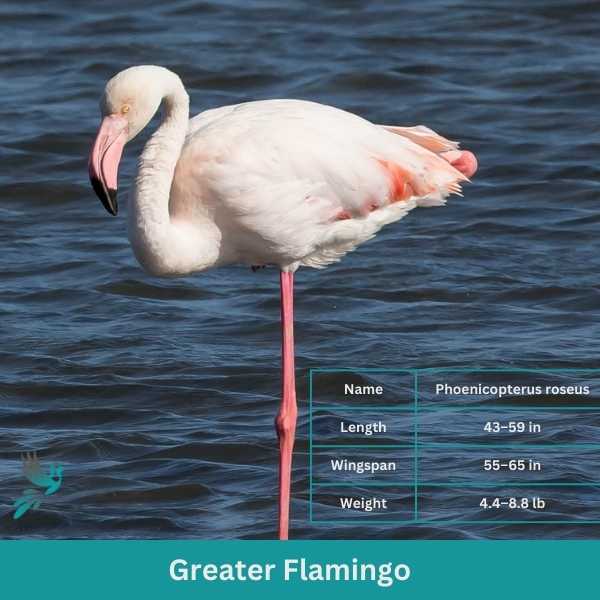
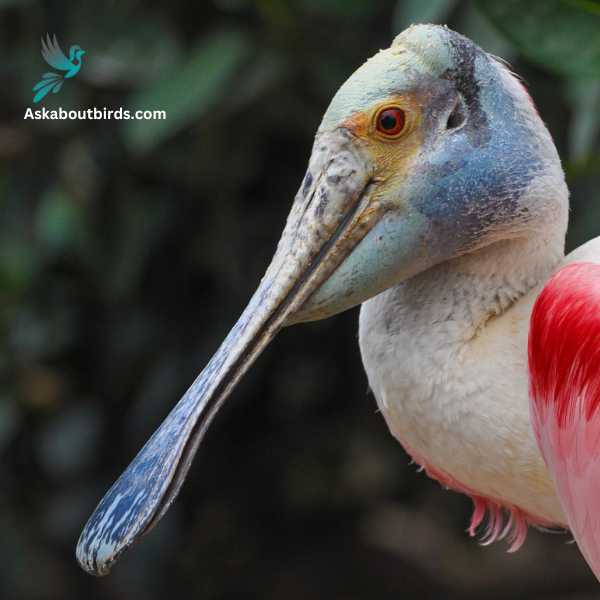
| Feature | Measurement |
|---|---|
| Scientific Name | Phoenicopterus roseus |
| Length | 43–59 in |
| Wingspan | 55–65 in |
| Weight | 4.4–8.8 lb |
The Greater Flamingo is a large and majestic bird known for its distinctive pink hue. These flamingos often gather in large colonies in shallow water bodies, feeding primarily on small aquatic creatures such as shrimp, mollusks, and algae which contribute to their pink color.
The Greater Flamingo is an incredibly tall, long-legged wading bird. Its signature bill is downward bending, pink with a black tip, and is unique in its filtering capabilities. The plumage ranges from pale pink to a brighter pink, and the intensity depends on the bird’s diet. The legs of the Greater Flamingo are also pink and quite lengthy, contributing to the bird’s tall stature. Young flamingos are grey and white and acquire the pink coloration after about two years.
The vocal sounds of the Greater Flamingo are quite varied, often described as goose-like honking, mumbling, or grunting noises, particularly noticeable in large colonies.
Lesser Flamingo
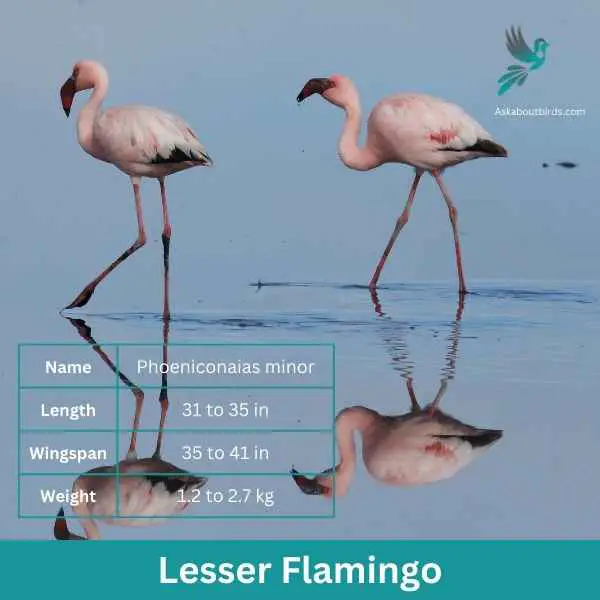
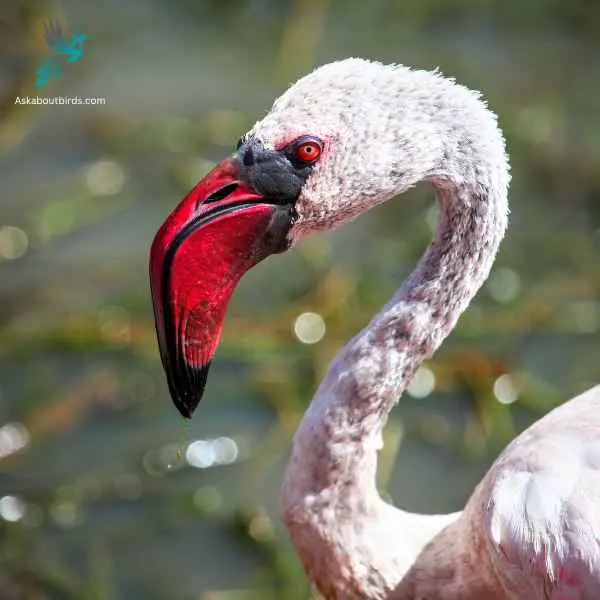
| Feature | Measurement |
|---|---|
| Scientific Name | Phoeniconaias minor |
| Length | 31 to 35 in |
| Wingspan | 35 to 41 in |
| Weight | 1.2 to 2.7 kg |
The Lesser Flamingo (Phoeniconaias minor) is the smallest species of flamingo, though still a large bird by most standards. It is most commonly found in Sub-Saharan Africa and parts of India, residing in saline lakes and lagoons. The Lesser Flamingo is distinguished by its deep rose-pink to white coloring, long neck, black-tipped bill with a distinctive downward curve, and thin, stick-like legs.
Despite being the most numerous flamingo species worldwide, the Lesser Flamingo’s population faces potential threats. The primary diet of these birds consists of algae and tiny organisms found in alkaline waters of their habitat, and they often congregate in huge, spectacular flocks for feeding and breeding. Unfortunately, changes in water quality or level can greatly affect their food availability. Additionally, they are also threatened by habitat loss and disturbances at breeding colonies. Conservation efforts for the Lesser Flamingo mainly involve protecting and managing their preferred habitats, monitoring populations, and implementing legislation against hunting and egg collection.
FAQS on Birds That Look Like Flamingos
What are the flamingo-like birds in Florida?
In Florida, several bird species bear a resemblance to Flamingos., birds known for their vibrant pink feathers and pink legs. The most notable among these are the Roseate Spoonbill, which sports pink plumage similar to a Flamingo, and the Reddish Egret, which shares the long-legged and long-necked appearance. Other similar species include the Great Blue Heron, White Ibis, and Sandhill Crane.
What are the blue birds that look like flamingos?
There aren’t many blue birds that closely resemble Flamingos, however we’ve pulled together quite a few birds that do hit the mark!. However, the Tricolored Heron (formerly known as the Louisiana Heron) is a wading bird with blue-gray plumage and long legs and neck, which may give an impression similar to Flamingos, albeit in a different color. The scarlet ibis with its bright red feathers also comes close to the distinctive pink plumage of Flamingos.
What is a pink crane-like bird?
The most familiar pink, crane-like bird is likely the Flamingo itself, but another bird that fits this description is the Roseate Spoonbill. This species is known for its stunning pink plumage and spoon-shaped bill, distinguishing it from cranes. However, its size and long legs could lead one to compare it to a crane.
What is the difference between a Spoonbill and a Flamingo?
While Spoonbills and Flamingos might seem similar due to their pink coloration and wading habits, they are quite different. Flamingos are generally taller, with longer necks and legs, and have a distinctive downward-curved bill adapted for filter-feeding. Spoonbills, on the other hand, are named for their unique spoon-shaped bills, which they swing side-to-side in the water to catch small aquatic animals.

